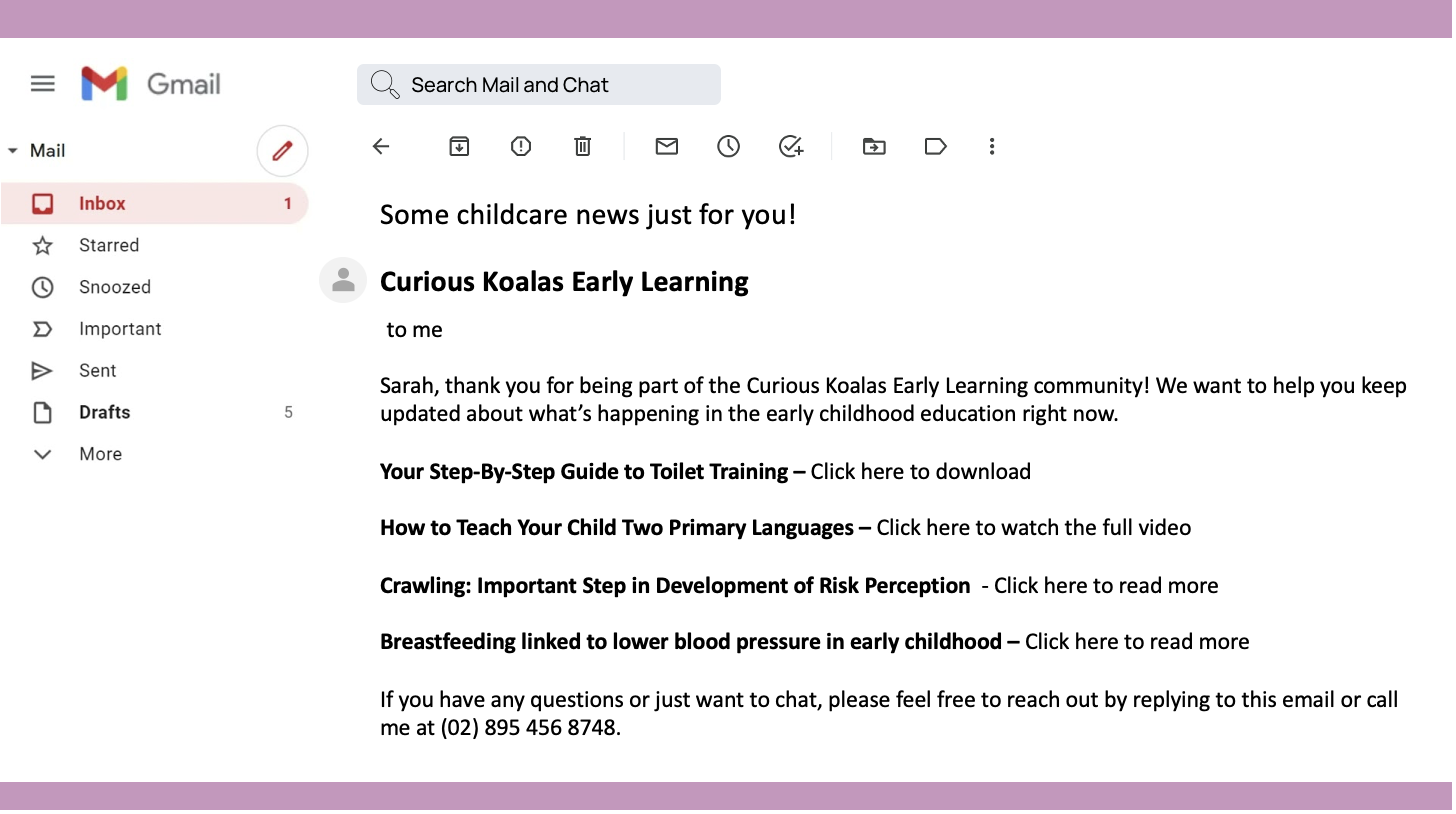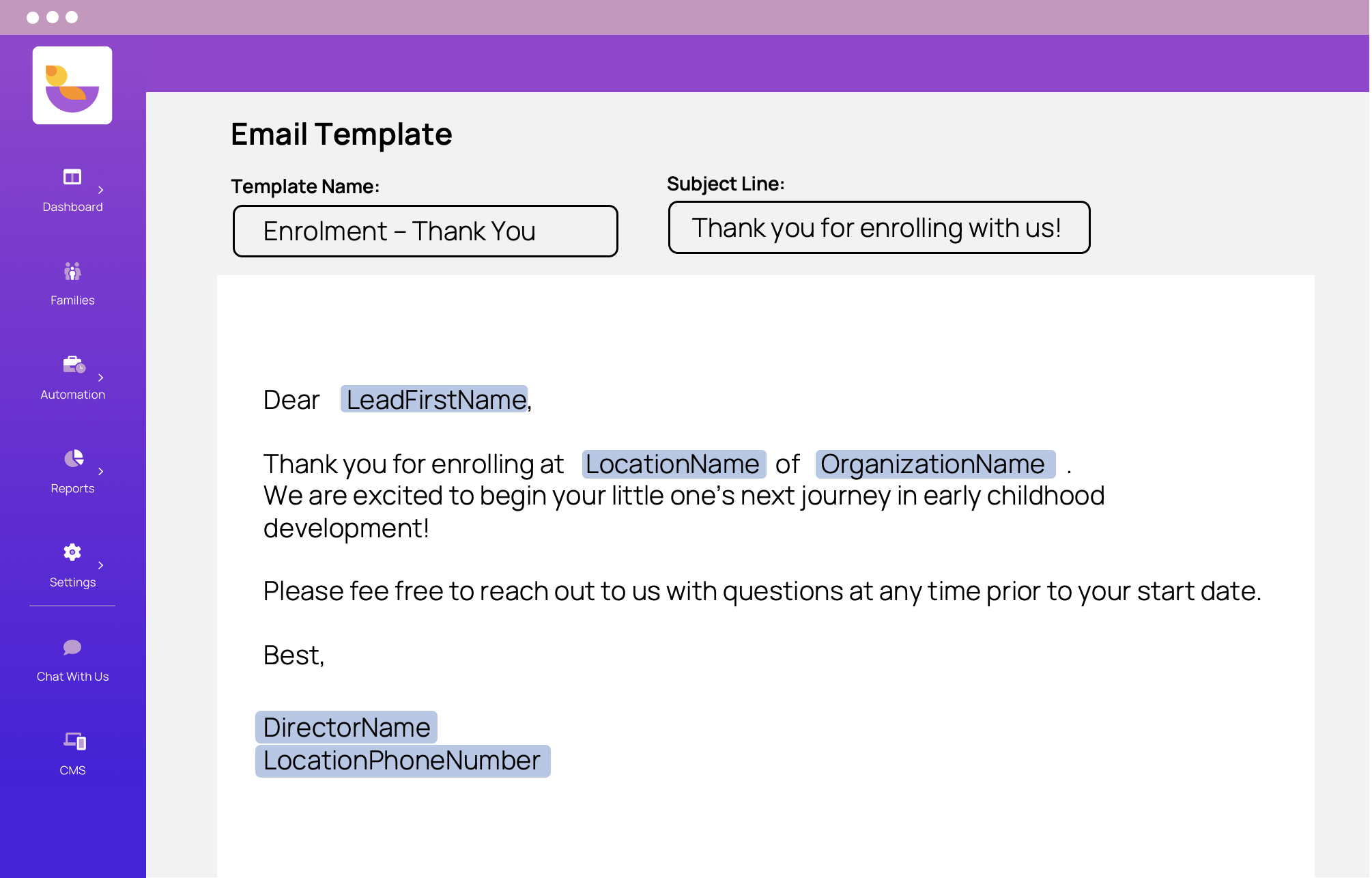How to build childcare
centre email marketing
campaigns like a pro
A step-by-step guide for childcare with actionable tips and example templates to help you develop an email strategy that converts.

See how to build email campaigns that convert.
There are a lot of factors to consider when you're trying to market to prospective parents or keep your enrolled families engaged with your centre.
Coming up with new strategies for childcare marketing isn't always easy but we've created this guide to help you remember the little details that can make a big difference in the success of your email campaigns.
Create a plan for your marketing email.
Don't just jump in the car and drive. Map out which direction you're going.
If you’re creating an email drip campaign, establish a schedule in advance and determine how often you want to send emails. Look ahead in your centre’s calendar and make note of upcoming holidays to plan your content around special dates and events. Set up your email response timetable to automatically send friendly messages parents will resonate with. Also, plan your follow-up conversations to fit the family's communication preferences by the way they interact with your emails. Stay top of mind by delivering custom messages tailored to your parents' needs.
Drip campaigns prevent childcare franchises and centres from leaving money on the table.
Impersonal content generates 83% lower response rates in an average marketing campaign than personalised messages. Today’s parents prefer communicating with businesses that humanise their communications.
Increase response rates with custom drip campaigns. For example, in a typical drip campaign, you might send out an email to all prospective parents who haven’t yet completed enrolment forms. Those who opened and clicked through could then be given a task in your CRM for a staff member to follow up with them by phone. Those who did not open the email could automatically be sent a text reminder. Drip campaigns tailor your enrolment experience to each parent. Never worry about leaving money on the table again with custom message that ensure your childcare brand sends the right message at the right time.

.png)
Nurture emails are essential to guide parents through enrolment.
Unfortunately, if you send too many emails too often, your messages may be diverted to spam or parents may simply unsubscribe. But don’t let that scare you! Start with sending 2-3 nurture emails at regular intervals to keep parents engaged. Also, sending one brief newsletter every 1-2 months helps to keep your audience engaged and invested in what’s going on at your organisation. Automate your email marketing campaigns with a childcare solution to follow-up quicker, gain leads faster, and avoid marketing mistakes caused by human error.
For help designing a newsletter for your childcare business, use Canva. They already have templates created specifically for daycares and preschools, most of which are free.

Plus, segment your email audience into smaller collections of people within your customer database. Customer email segmentation is a personalisation tactic. At its core, customer segmentation (also commonly referred to as market segmentation) in childcare can be best described as the separation of prospective parents into various groups based on their enrolment needs, such as children’s ages, whether they are seeking full time or part-time care, and more.
For example, if you’re attempting to fill open spots in your toddler's room, group the contact information from families that have enquired at your school with children who are roughly 18-24 months old.
Use an attention-grabbing subject line
The email subject line is often the determining factor in whether a reader will open your email. In fact, 47% of email recipients open an email based on the subject line. To ensure your emails are being received and read, your subject should be on-topic with your email but catchy enough to capture attention and boost your email open rates.
Here are some tips when designing an email subject line:
Utilise the fear of missing out.
Humans are naturally afraid of missing out on something better, being left out, or not having what someone else has. By simply including words that imply time sensitivity or limited availability, parents will be more inclined to reach out to your centre sooner rather than later.
Examples
- "[PRIORITY] Last toddler spot available until next year!"
- "Don't miss out on early enrolment"
- "Our waitlist is almost full!"
- "[URGENT] One more day until our Open Day"
Appeal to parent's curiosity.
Humans are naturally afraid of missing out on something better, being left out, or not having what someone else has. By simply including words that imply time sensitivity or limited availability, parents will be more inclined to reach out to your centre sooner rather than later.
Examples
- "Simple ways to improve toddler communication."
- "4 new trends in raising preschool-aged children."
- "Check out what other parents are doing."
- "Does your child do these things?"
Add Emojis
Aside from being really cute and fun to look at, using email emojis has major marketing benefits. Adding emojis to your email subject lines is a great way to draw attention from parents. In fact, 56% of brands that used emojis in their subject lines had higher open rates.
Examples
- 📅 "Only a few spots left for tours this week!"
- "The time to enrol is now." 📅
- "Prepare your child for kindergarten." 📅
Use clean formatting.
Refrain from overwhelming readers by avoiding using too much capitalisation or too many punctuation marks. Using all caps or five exclamation points in your subject line tends to rub parents the wrong way. No one wants to be yelled at, either in person or via email. It's okay to use a question mark or an exclamation point every now and then, just not more than one at a time.
Examples
- "TIPS to encourage your child to share."
- "Schedule a tour today before it's too late!"
- "Is your child ready for kindergarten?"
Make it engaging with pictures.
Putting authentic images in your email marketing campaigns is going to capture your readers’ attention. Use pictures and post quality photos that are relevant to the topic and that will leave a lasting impression.
Whether it’s a festive holiday picture or a goofy picture of the children in your centre with funny hats on, make sure parents will remember it. It’s also important to keep in mind that you should never use pictures of any children from your centre without their parent’s written permission. In fact, ask willing parents to sign a marketing release form well in advance so that you have photos readily available when you need them.
Use your logo and branding elements.
Branding and logos are essential when you’re thinking about how to advertise a childcare centre. For larger childcare businesses, consider multi-centre brand emails across your organisation. Your branded email elements should consist of the graphic signature of your centre’s communications and should provide a basis for the fonts, colours, and design choices in all of your marketing materials.
In particular, when designing your email signature, use fonts that are easily readable and break up important contact information into different lines so parents can find how to reach you at a quick glance. It’s also recommended that you include your logo and any links to your website or social media at the bottom of your signature.
Nearly all of today’s Millennial parents to children under the age of 12 are active on social media. If you have social media accounts or a blog, share the links in your email signature line for the reader to find more information. Use these links to point your readers to places where they can access other website resources or program information.
Personalise your messaging
If you want your communications to stand out from the rest, it’s important to connect with your reader. Build a personal connection with parents by adding personalisation keys. Make parents feel special and attended to when they receive an email from you by adding their name at the beginning of the email. It immediately gives parents a feeling of belonging to your centre before they even enrol.
Consider the parent experience
The parent experience is often time-consuming, inconvenient, and impersonal. Beyond using their name or their child’s name in an email, use the information you already know about this family to relate to them and write engaging content that is tailored to their specific program interests and care needs.
For example, if a parent is seeking healthy meal options for their child, include details about this week’s menu, highlighting areas with fresh veggies, fruits, or other health-focused items. Plus, automate personalisation keys, schedule targeted drip campaigns to send at the right time, and gather more family data to enhance your marketing.
Keep your copy brief
Nearly 80% of people are only scanning your email’s key points. Your first sentence is the most important so keep your most important points at the top. Try not to make your email too long, keep it to the point to make it easy for parents to scan quickly by using bullet points or numbered lists. The ideal email copy length is between 50 to 125 words and can result in email response rates over 50%. Although this may not seem like a lot, brief copy simply performs better.
Engage the reader in a conversation.
Making your message seem like more of a conversation than a lecture leads to higher response rates and greater engagement. Keep your message interesting and informative by including:
- parent testimonials
- updates about your staff and programs
- and information about upcoming events and celebrations.
Try asking questions throughout your email that get your audience to agree with you and want to communicate more. For example, if you’re writing an email about important milestones in young children, ask parents about how exciting it was when their child first started walking or what their first word was.
This helps begin a conversation that is meaningful to them and their family while also allowing you to learn more personal information that will help you better market to them in the long run.

Measure your performance.
It's essential to track your marketing performance in childcare because you want to know which emails, campaigns, content, ads and posts are the most effective. ChildcareCRM offers several reports that show you how many people have read your email, responded to you, and whether they clicked any of the links within the email. Keep a childcare checklist to remember important reports and measure your email performance.
Additionally, most people check their email first thing in the morning so the best time to check your email performance in the afternoon.
Click-To-Open Rate
Beyond identifying overall email performance (which is a culmination of many different factors), the Click-To-Open Rate (CTOR) only examines the success of the content within your email. This means that the CTOR is tracking how many people clicked your links only relative to the number of people who actually opened the email. Your average click-to-open rate should be between 20-30%.
Recommended email delivery rate for childcare businesses.
Get started With LineLeader.
Resources to help you run your childcare business.



